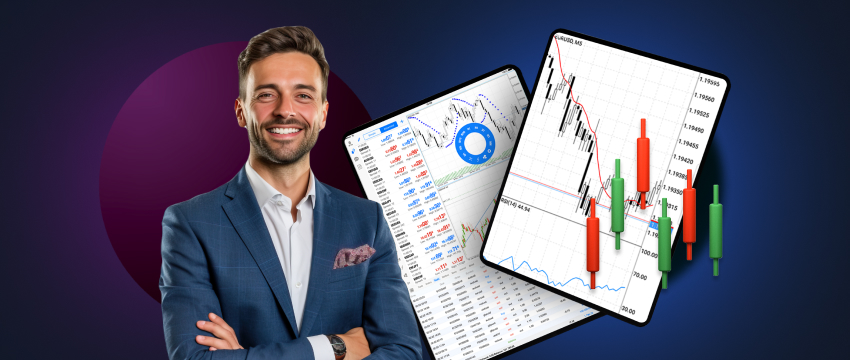There are many ways to approach trading. There are multiple types of trades, and each one comes with its own unique characteristics, time frames, goals, and strategies.
Understanding the different types of trades is key to choosing one that best aligns with your personality, temperament, budget, and skill.
In this article, we’ll discuss four of the most popular types of trades: scalping, swing investing, day investing, and position investing.

O scalping
Scalping is a short-term strategy. Scalpers typically execute a high volume of transactions within the day to profit from small price movements, holding positions for only a few seconds to minutes and closing them before the trading day ends.
Scalping is not for the faint hearted, however. It’s fast-paced, high-stress, and demands constant focus and monitoring. Traders must make decisions incredibly quickly and use strategic risk management to handle aggressive price fluctuations and market volatility.
Scalpers must be very mindful of every investment decision to minimise losses, especially when the gains per trade are often minimal, so a high win rate is the goal to maintain profitability.
Negociação diária
Like scalping, day trading is also considered a shorter-term approach. Day traders usually enter and exit multiple transactions within the same trading day, and don’t hold positions overnight.
A day trader must be as disciplined as a scalper and have a solid understanding of short-term market trends to better manage positions held for minutes or hours.
Day traders rely heavily on technical analysis to make investment decisions. This includes studying chart patterns and using short-term indicators like oscillators, moving averages, RSI, and others. Effective risk management is also vital in day trading.
The implementation of tools like stop-loss orders to limit losses, or take-profit orders to lock in profits, can significantly enhance risk management strategies by automating trade exits. This reduces emotional decision making and ensures a more focused approach to handling trades.
Na negociação de swing
Unlike scalping or day trading, swing trading is a more medium-term approach to engaging in the markets. Swing traders usually hold positions for several days to weeks, depending on market conditions.
Although constant monitoring is not strictly required, risk management remains essential since positions are held overnight. This exposes transactions to adverse outcomes from unexpected news announcements or events that can drive prices in unanticipated directions.
Seeing as swing traders will hold onto positions for longer periods, they will use devida análise together with some form of fundamental when the need arises, to gain a wider perspective of potential trade performance.
Swing trading is usually bested suited to someone with some market experience and for those who have less time to commit to monitoring the markets constantly, like scalpers or day traders.
Swing traders are usually patient and will stick to their investment plan to improve their potential for success. They also have a fairly high tolerance for risk, taking into account overnight positions and exposure to weekend gaps.

A negociação de posições
In contrast to the other trading approaches, a position investor is usually in it for the long haul. They hold onto positions for weeks, months and sometimes even years. Their objective is to maximise potential gains from long-term price movements.
Because position trading is less time-sensitive than scalping or swing trading, position traders don’t monitor the market continuously. However, they make heavy use of fundamental analysis to make trading decisions.
This includes monitoring the financial health of a company, the health of the wider economy, global events, and more. This is not to say they don’t use technical analysis; they do – to identify entry and exit points.
Position trading does come with its own set of challenges too though. Holding positions for extended periods exposes traders to a wide range of market risks, including geopolitical uncertainties, economic downturns, and more.
Picking a trading style that aligns with your goals
Picking a trading approach fundamentally comes down to your risk tolerance, the amount of time you have to commit to trading, your level of expertise, and of course, your financial objectives.
O tempo que irá dedicar:
- If you’re looking to engage in scalping or day trading, keep in mind that you’ll need a significant number of hours per day to devote to analysing charts, monitoring market trends, and managing transactions.
- Both strategies need continuous attention to market movements to be able to capitalise on short or medium-term price fluctuations.
- On the other hand, swing investing or position investing offer more flexibility, with less time needed for constant monitoring.
Gestão de risco:
- Regardless of what approach you opt to deploy, risk management will play an essential role to safeguard your capital.
- Risk management looks different for different traders. There is the implementation of stop-loss and take-profit orders for most traders.
- Others may also choose to be particularly mindful about position sizing, ensuring they don’t invest all their capital into one trade, putting all their funds at risk.
- Some traders may also opt for portfolio diversification, sharing the risk among multiple assets rather than on just one asset class.
Ongoing education:
- Picking a trading approach is also very much dependent on the expertise and knowledge a trader possesses. One of the ways that an investor ensures both is by engaging in some form of ongoing learning so that they fully understand the strategy they will be implementing. There are many ways that traders acquire a trading-related education.
- Signing up with a reputable broker for instance generally provides traders with access to a broad range of resources. For example, T4Trade offers a mix of webinars, podcasts, videos-on-demand, e-books, blogs, and even Live TV.
- These provide market insights, tips, ideas, strategies and concepts to help an investor boost their skills and widen their scope of information. Additionally, traders often times make use of a demo account to refine their skills.
- Regardless of expertise, both beginner and professional traders can use a demo account to test out a variety of strategies to determine which one suits them best.
- They are able to do this in a simulated investment environment which mimics real market conditions. Using virtual funds, traders can execute any number of transactions without putting their own money at risk.
Trading psychology:
- Having a strong trading psychology is key no matter what type of trades you choose. Decisions driven by emotions often have adverse outcomes, focus should instead be placed on using objective data to execute transactions. Work on ensuring you keep calm, level-headed and not having your judgement clouded by feelings of fear, panic, greed or anxiety.
It’s clear that there is no one size fits all approach to trading. Picking a strategy ultimately depends on your personality, your daily routines, and available budget set aside. Trading can be a part-time endeavour or a full-blown career, both of which offer a way to make some gains.

Negociar com a T4Trade
T4Trade is a popular global broker with clients worldwide. The broker offers top-tier, 24/5 multilingual customer support, cutting-edge platforms, and flexible trading conditions. T4Trade is also a great go-to resource for traders looking to learn more about forex trading in a user-friendly way.
Os traders do T4Trade também podem escolher entre 300 instrumentos de negociação em 6 classes de ativos e dispõem de alavancagem flexível, spreads competitivos, rapidez de execução das negociações e facilidade nos levantamentos e depósitos.
T4Trade traders can also choose from a wide range of trading instruments across 6 asset classes, and enjoy flexible leverage, competitive spreads, fast trade execution and seamless deposit and withdrawal options. Traders can also choose from multiple trading accounts that best suit their needs and individual preferences.
AVISO LEGAL: A informação disposta não deve ser interpretada como consultoria financeira ou recomendação de investimento, sendo apresentada apenas para fins de comunicação e marketing.




